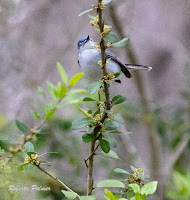BLUE-GRAY GNATCATCHER
BLUE-GRAY GNATCATCHER – (Polioptila caerulea) (See images below)
DESCRIPTION: The Blue-gray Gnatcatcher is mostly blue-grey on top (as its name implies). The wings have no blue tinge. The under parts are white. The grey tail is almost half the bird’s length, and the outer feathers are white, thus helping with identification when the bird is flying. Females have no blue. Both sexes have a white eye ring, black eyes and legs, and a grey bill. It is a tiny songbird at around 12 cm (5 inches) long.
VOICE: https://www.xeno-canto.org/species/Polioptila-caerulea – The blue-gray gnatcatcher is known to include parts of other species songs in its repertoire, thus earning the nickname of ‘Little Mockingbird’.
NAME: The English name ‘Gnatcatcher’ refers to the bird’s diet. The Latin genus name ‘Polioptila’ comes from ancient Greek and means ‘grey feathers’, and the Latin species name ‘caerulea’ refers to a type of blue.
HABITAT: Mixed forest, preferably moist with rivers or streams for example.
DIET: Gnats, but also other insects and arthropods such as spiders.
NESTING: The nest is a conical structure built on a branch near the edge of their habitat, rather high in a tree. Around four or five light blue eggs are laid, incubated by both parents, who also both feed the chicks.
DISTRIBUTION: The breeding range in Canada only covers the north side of Lakes Erie and Ontario, with the main part in most of the contiguous states of the USA, except the northwest region. It is a year-round resident in Florida and Mexico, and the northern population migrates to Central America and the Caribbean.
DISTRIBUTION MAP: https://en.wikipedia.org/wiki/Blue-gray_gnatcatcher#/media/File:Polioptila_caerulea_map.svg
ON PEI: The Blue-gray Gnatcatcher is the only species of this genus observed on Prince Edward Island. It does not breed on the island, and its occurrence is occasional or uncommon depending on the seasons.
CONSERVATION: The large population of the blue-gray gnatcatchers appears to be increasing and it is also expanding its breeding range, notably in the north eastern part of the USA. This trend seems to be linked to climate change.
SIMILAR SPECIES: Golden-crowned Kinglet, Ruby-crowned Kinglet
REFERENCES: https://www.audubon.org/field-guide/bird/blue-gray-gnatcatcher
https://en.wikipedia.org/wiki/Blue-gray_gnatcatcher
https://www.allaboutbirds.org/guide/Blue-gray_Gnatcatcher/id
https://www.thespruce.com/blue-gray-gnatcatcher-385821
https://identify.whatbird.com/obj/351/_/Blue-gray_Gnatcatcher.aspx
Minnesota Breeding Bird Atlas (Blue-gray Gnatcatcher)
DESCRIPTION: The Blue-gray Gnatcatcher is mostly blue-grey on top (as its name implies). The wings have no blue tinge. The under parts are white. The grey tail is almost half the bird’s length, and the outer feathers are white, thus helping with identification when the bird is flying. Females have no blue. Both sexes have a white eye ring, black eyes and legs, and a grey bill. It is a tiny songbird at around 12 cm (5 inches) long.
VOICE: https://www.xeno-canto.org/species/Polioptila-caerulea – The blue-gray gnatcatcher is known to include parts of other species songs in its repertoire, thus earning the nickname of ‘Little Mockingbird’.
NAME: The English name ‘Gnatcatcher’ refers to the bird’s diet. The Latin genus name ‘Polioptila’ comes from ancient Greek and means ‘grey feathers’, and the Latin species name ‘caerulea’ refers to a type of blue.
HABITAT: Mixed forest, preferably moist with rivers or streams for example.
DIET: Gnats, but also other insects and arthropods such as spiders.
NESTING: The nest is a conical structure built on a branch near the edge of their habitat, rather high in a tree. Around four or five light blue eggs are laid, incubated by both parents, who also both feed the chicks.
DISTRIBUTION: The breeding range in Canada only covers the north side of Lakes Erie and Ontario, with the main part in most of the contiguous states of the USA, except the northwest region. It is a year-round resident in Florida and Mexico, and the northern population migrates to Central America and the Caribbean.
DISTRIBUTION MAP: https://en.wikipedia.org/wiki/Blue-gray_gnatcatcher#/media/File:Polioptila_caerulea_map.svg
ON PEI: The Blue-gray Gnatcatcher is the only species of this genus observed on Prince Edward Island. It does not breed on the island, and its occurrence is occasional or uncommon depending on the seasons.
CONSERVATION: The large population of the blue-gray gnatcatchers appears to be increasing and it is also expanding its breeding range, notably in the north eastern part of the USA. This trend seems to be linked to climate change.
SIMILAR SPECIES: Golden-crowned Kinglet, Ruby-crowned Kinglet
REFERENCES: https://www.audubon.org/field-guide/bird/blue-gray-gnatcatcher
https://en.wikipedia.org/wiki/Blue-gray_gnatcatcher
https://www.allaboutbirds.org/guide/Blue-gray_Gnatcatcher/id
https://www.thespruce.com/blue-gray-gnatcatcher-385821
https://identify.whatbird.com/obj/351/_/Blue-gray_Gnatcatcher.aspx
Minnesota Breeding Bird Atlas (Blue-gray Gnatcatcher)
 |
| Blue-gray gnatcatcher, Roberta Palmer |
 |
| Blue-gray gnatcatcher, Roberta Palmer |